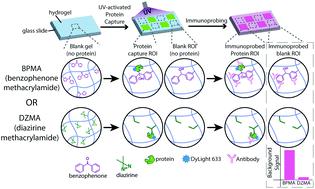Our official English website, www.x-mol.net, welcomes your
feedback! (Note: you will need to create a separate account there.)
Comparison of photoactivatable crosslinkers for in-gel immunoassays
Analyst ( IF 3.6 ) Pub Date : 2021-09-30 , DOI: 10.1039/d1an01309b Kristine Y Tan 1 , Surbhi Desai 2 , Erum Raja 2 , Chris Etienne 2 , Brian Webb 2 , Amy E Herr 1, 3
Analyst ( IF 3.6 ) Pub Date : 2021-09-30 , DOI: 10.1039/d1an01309b Kristine Y Tan 1 , Surbhi Desai 2 , Erum Raja 2 , Chris Etienne 2 , Brian Webb 2 , Amy E Herr 1, 3
Affiliation

|
While fluorescence readout is a key detection modality for hydrogel-based immunoassays, background fluorescence due to autofluorescence or non-specific antibody interactions impairs the lower limit of detection of fluorescence immunoassays. Chemical modifications to the hydrogel structure impact autofluorescence and non-specific interactions. Benzophenone is a common photoactivatable molecule, and benzophenone methacrylamide (BPMA) has been used for cross-linking protein in polyacrylamide (PA) hydrogels. However, previous studies have suggested that the aromatic structure of benzophenone can contribute to increased autofluorescence and non-specific hydrophobic interactions with unbound fluorescent probes. Here, we synthesize diazirine methacrylamide (DZMA) as an alternative photoactivatable molecule to crosslink into PA hydrogels for in-gel protein capture for in-gel immunoassays. We hypothesize that the less hydrophobic structure of diazirine (based on previously reported predicted and experimental log P values) exhibits both reduced autofluorescence and non-specific hydrophobic interactions. We find that while equal concentrations of DZMA and BPMA result in lower protein target photocapture in the diazirine configuration, increasing the DZMA concentration up to 12 mM improves in-gel protein capture to be on par with previously reported and characterized 3 mM BPMA hydrogels. Furthermore, despite the higher concentration of diazirine, we observe negligible autofluorescence signal and a 50% reduction in immunoassay fluorescence background signal in diazirine gels compared to BPMA gels resulting in comparable signal-to-noise ratios (SNR) of the probed protein target. Finally, we test the utility of DZMA for single-cell immunoblotting in an open microfluidic device and find that protein migrates ∼1.3× faster in DZMA hydrogels than in BPMA hydrogels. However, in DZMA hydrogels we detect only 15% of the protein signal compared to BPMA hydrogels suggesting that the diazirine chemistry results in greater protein losses following electrophoretic separations. We establish that while diazirine has lower background fluorescence signal, which may potentially improve immunoassay performance, the lower capture efficiency of diazirine reduces its utility in open microfluidic systems susceptible to sample losses.
中文翻译:

用于凝胶免疫分析的光活化交联剂的比较
虽然荧光读数是基于水凝胶的免疫测定的关键检测方式,但由于自发荧光或非特异性抗体相互作用导致的背景荧光损害了荧光免疫测定的检测下限。对水凝胶结构的化学修饰会影响自发荧光和非特异性相互作用。二苯甲酮是一种常见的光活化分子,二苯甲酮甲基丙烯酰胺 (BPMA) 已被用于聚丙烯酰胺 (PA) 水凝胶中的蛋白质交联。然而,先前的研究表明,二苯甲酮的芳香结构有助于增加自发荧光和与未结合荧光探针的非特异性疏水相互作用。这里,我们合成二氮丙啶甲基丙烯酰胺 (DZMA) 作为替代光活化分子,以交联到 PA 水凝胶中,用于凝胶内蛋白质捕获,用于凝胶内免疫测定。我们假设二氮嗪疏水性较低的结构(基于先前报道的预测和实验日志 磷值)表现出减少的自发荧光和非特异性疏水相互作用。我们发现,虽然等浓度的 DZMA 和 BPMA 导致二氮嗪配置中蛋白质目标光捕获较低,但将 DZMA 浓度增加至 12 mM 可改善凝胶内蛋白质捕获,与先前报道和表征的 3 mM BPMA 水凝胶相当。此外,尽管二氮嗪的浓度较高,但我们观察到与 BPMA 凝胶相比,二氮嗪凝胶中的自发荧光信号可忽略不计,免疫测定荧光背景信号降低了 50%,从而导致探测的蛋白质靶标的信噪比 (SNR) 相当。最后,我们测试了 DZMA 在开放微流体装置中用于单细胞免疫印迹的效用,发现蛋白质在 DZMA 水凝胶中的迁移速度比在 BPMA 水凝胶中快 1.3 倍。然而,在 DZMA 水凝胶中,与 BPMA 水凝胶相比,我们仅检测到 15% 的蛋白质信号,这表明二氮嗪化学导致电泳分离后更大的蛋白质损失。我们确定,虽然二氮嗪具有较低的背景荧光信号,这可能会提高免疫测定性能,但二氮卓的较低捕获效率降低了其在易受样品损失影响的开放微流体系统中的效用。
更新日期:2021-09-30
中文翻译:

用于凝胶免疫分析的光活化交联剂的比较
虽然荧光读数是基于水凝胶的免疫测定的关键检测方式,但由于自发荧光或非特异性抗体相互作用导致的背景荧光损害了荧光免疫测定的检测下限。对水凝胶结构的化学修饰会影响自发荧光和非特异性相互作用。二苯甲酮是一种常见的光活化分子,二苯甲酮甲基丙烯酰胺 (BPMA) 已被用于聚丙烯酰胺 (PA) 水凝胶中的蛋白质交联。然而,先前的研究表明,二苯甲酮的芳香结构有助于增加自发荧光和与未结合荧光探针的非特异性疏水相互作用。这里,我们合成二氮丙啶甲基丙烯酰胺 (DZMA) 作为替代光活化分子,以交联到 PA 水凝胶中,用于凝胶内蛋白质捕获,用于凝胶内免疫测定。我们假设二氮嗪疏水性较低的结构(基于先前报道的预测和实验日志 磷值)表现出减少的自发荧光和非特异性疏水相互作用。我们发现,虽然等浓度的 DZMA 和 BPMA 导致二氮嗪配置中蛋白质目标光捕获较低,但将 DZMA 浓度增加至 12 mM 可改善凝胶内蛋白质捕获,与先前报道和表征的 3 mM BPMA 水凝胶相当。此外,尽管二氮嗪的浓度较高,但我们观察到与 BPMA 凝胶相比,二氮嗪凝胶中的自发荧光信号可忽略不计,免疫测定荧光背景信号降低了 50%,从而导致探测的蛋白质靶标的信噪比 (SNR) 相当。最后,我们测试了 DZMA 在开放微流体装置中用于单细胞免疫印迹的效用,发现蛋白质在 DZMA 水凝胶中的迁移速度比在 BPMA 水凝胶中快 1.3 倍。然而,在 DZMA 水凝胶中,与 BPMA 水凝胶相比,我们仅检测到 15% 的蛋白质信号,这表明二氮嗪化学导致电泳分离后更大的蛋白质损失。我们确定,虽然二氮嗪具有较低的背景荧光信号,这可能会提高免疫测定性能,但二氮卓的较低捕获效率降低了其在易受样品损失影响的开放微流体系统中的效用。











































 京公网安备 11010802027423号
京公网安备 11010802027423号